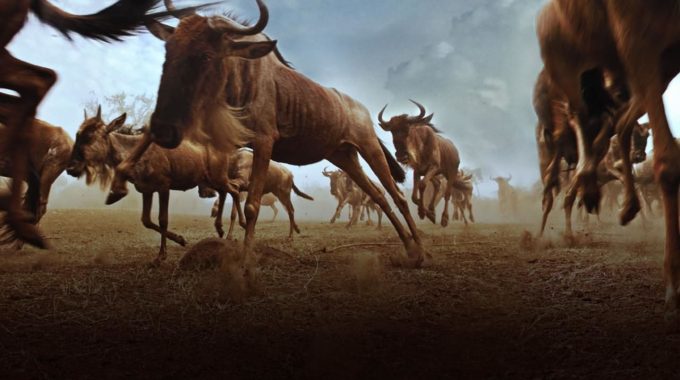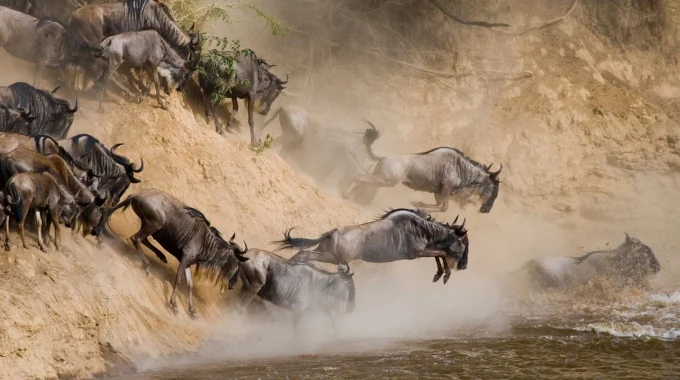How fast do wildebeest reproduce? - Wildebeests (Connochaetes spp.) are iconic members of the African savannas…
Is the Great wildebeest migration a wonder of the world?
The Great Wildebeest Migration: A Natural Wonder of the World

Is the Great wildebeest migration a wonder of the world? – The Great Wildebeest Migration is widely regarded as one of the most awe-inspiring natural phenomena on Earth. While not officially recognized as one of the Seven Wonders of the World, the migration is often described as a “natural wonder” due to its scale, complexity, and dramatic beauty. Every year, over 1.5 million wildebeest, along with hundreds of thousands of zebras, gazelles, and other herbivores, embark on a journey across the savannas and grasslands of the Serengeti in Tanzania and the Maasai Mara in Kenya. This remarkable spectacle of animal movement has captivated the imagination of wildlife enthusiasts, travelers, and conservationists alike. But what is it about this migration that warrants its description as a “wonder,” and why should it be considered one of the world’s most extraordinary natural phenomena?
The Magnitude of the Migration
One of the key elements that make the Great Wildebeest Migration so impressive is the sheer scale of the event. It is often referred to as the largest overland migration in the animal kingdom. Each year, 250,000 zebras and about 500,000 gazelles join an estimated 1.5 million wildebeest in a continuous loop across the Serengeti-Mara ecosystem. The seasonal rains’ rhythms drive this enormous number of animals as they travel hundreds of miles in search of food and water. The migration is an epic journey that spans thousands of kilometers and takes place over the course of several months, from the southern plains of the Serengeti to the northern reaches of the Maasai Mara and back.
The scale of the migration can only be fully appreciated when witnessing it firsthand. The sheer volume of animals moving together, stretching across the landscape in a mass of hooves, dust, and calls, is a spectacle that inspires awe in those fortunate enough to witness it. In some places, the number of wildebeest can seem almost overwhelming, with the herds flowing like a living river across the savanna.
The Drama and the Dangers
What makes the Great Wildebeest Migration so compelling is not just the scale but the drama that unfolds during the journey. The migration is fraught with danger, as the animals must navigate numerous obstacles and threats along the way. One of the most perilous aspects of the migration is the river crossings. The wildebeest and other herbivores must cross rivers such as the Mara River, where they face the constant threat of crocodiles lurking in the water and lions, leopards, and hyenas waiting on the banks to take advantage of the vulnerable animals. These river crossings, particularly the Mara River crossing, are iconic moments of the migration and are often captured in breathtaking photographs and documentaries. The spectacle of thousands of wildebeest plunging into the water, unaware of the predators waiting beneath the surface, is a testament to the raw power of nature.
The danger is not limited to the rivers, however. Throughout the migration, the animals face threats from predators, hunger, and fatigue. The wildebeest must constantly stay alert to the movements of lions, cheetahs, and hyenas, who are often in hot pursuit. While some individuals will inevitably fall victim to predators, the migration’s ultimate purpose is survival: for the species as a whole, the migration is crucial to ensuring access to the best grazing land and maintaining their populations.
The Rhythms of Nature
The Great Wildebeest Migration is more complex and alive than it is in the traditional sense; it follows the cycles of nature. The availability of food and water, which in turn depends on the East African seasonal rains, determines the timing of the migration. The wildebeest follow their instincts and environmental cues, reacting to subtle changes in the landscape that indicate when and where to move. The movement of the herds is not haphazard but follows an annual pattern that has been perfected over millennia, ensuring that the animals arrive at specific locations when the grass is at its most nutritious.
This delicate balance between the animals and their environment is what makes the migration so fascinating. It is a demonstration of nature’s interconnectedness and the survival strategies of the species involved. At a deeper level, the migration also symbolizes the cyclical nature of life itself: birth, death, and rebirth all take place as part of this great journey. Each year, the herds give birth to thousands of calves, ensuring that the migration continues into the future. The dramatic aspects of the migration, including the river crossings and predator-prey interactions, are a reflection of the inherent violence and beauty of life in the wild.
Ecological and Cultural Significance
The Great Wildebeest Migration is not only a marvel for wildlife enthusiasts but also has profound ecological and cultural significance. The migration helps to maintain the health of the savanna ecosystem by preventing overgrazing and allowing plant life to regenerate. The constant movement of large herds also creates a mosaic of habitats, with new plant species able to grow as the animals move on. Furthermore, the presence of large predators helps to regulate the populations of herbivores, maintaining a balanced ecosystem.
Culturally, the migration is a symbol of Africa’s wild heart. For the indigenous people of East Africa, the migration is deeply intertwined with their lives and traditions. The Maasai, for example, have lived alongside the wildebeest for centuries, and their cultural practices are often connected to the rhythms of the land and the animals. The migration also draws millions of tourists each year, contributing significantly to the economies of Kenya and Tanzania. It is a major highlight for safari-goers and an essential part of the region’s tourism industry.
Why It Should Be Considered a Wonder
While the Great Wildebeest Migration is not officially recognized as one of the Seven Wonders of the World, it certainly meets the criteria for being considered a natural wonder. The migration’s size, its complexity, and the raw drama that unfolds during it make it one of the most unique and awe-inspiring phenomena on the planet. It is a celebration of life, survival, and nature’s power, and it represents the very essence of the wild. As such, it holds a special place in the hearts of those who have witnessed it and remains an enduring symbol of Africa’s natural heritage.
In conclusion, the Great Wildebeest Migration is more than just a spectacular wildlife event. It is a powerful reminder of the interconnectedness of life on Earth, the resilience of nature, and the fragility of ecosystems. While it may not be officially recognized as a “Wonder of the World,” it undoubtedly holds a place as one of nature’s most magnificent and awe-inspiring spectacles. Whether experienced in person or through the lens of a documentary, the Great Wildebeest Migration continues to capture the imagination and hearts of people around the world, cementing its status as one of the world’s greatest natural wonders.



